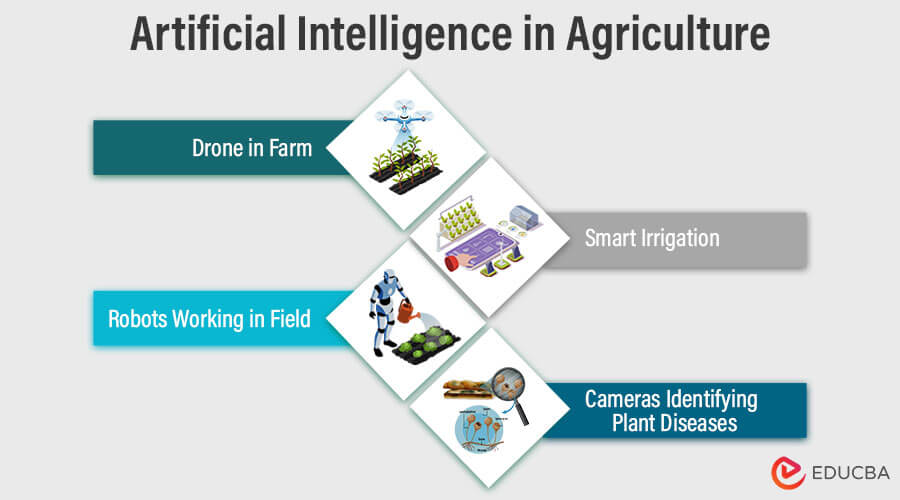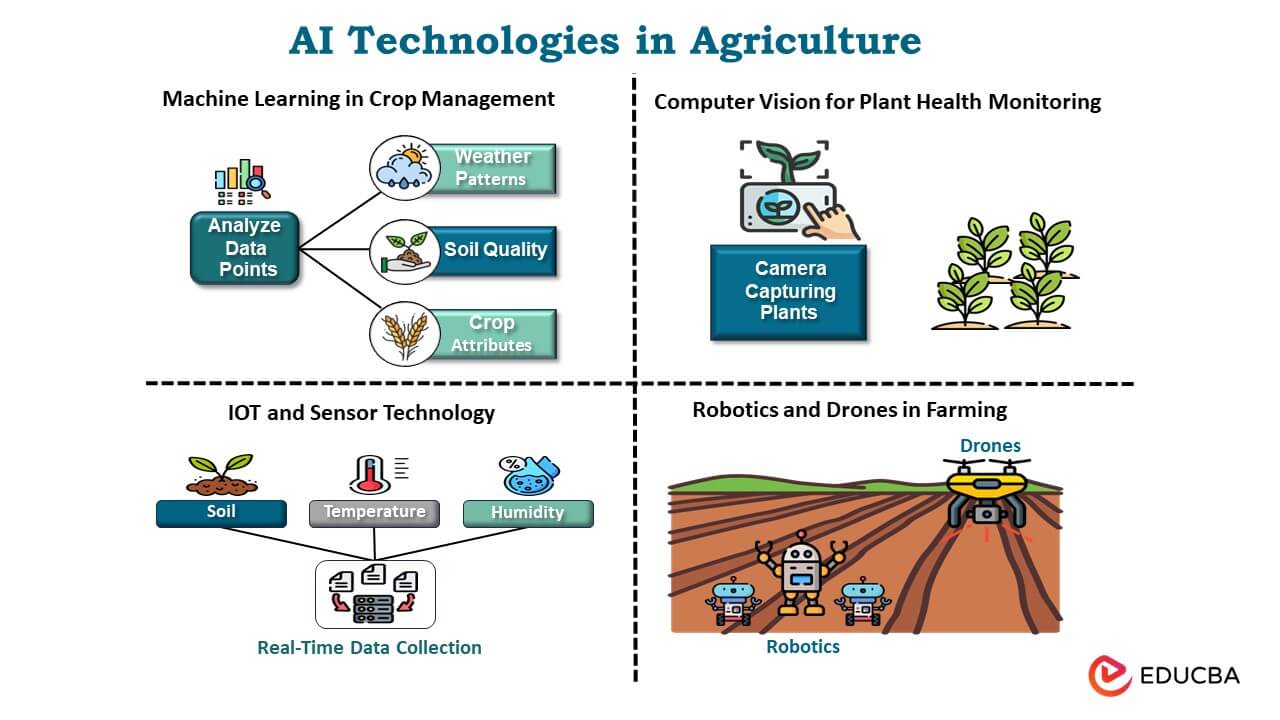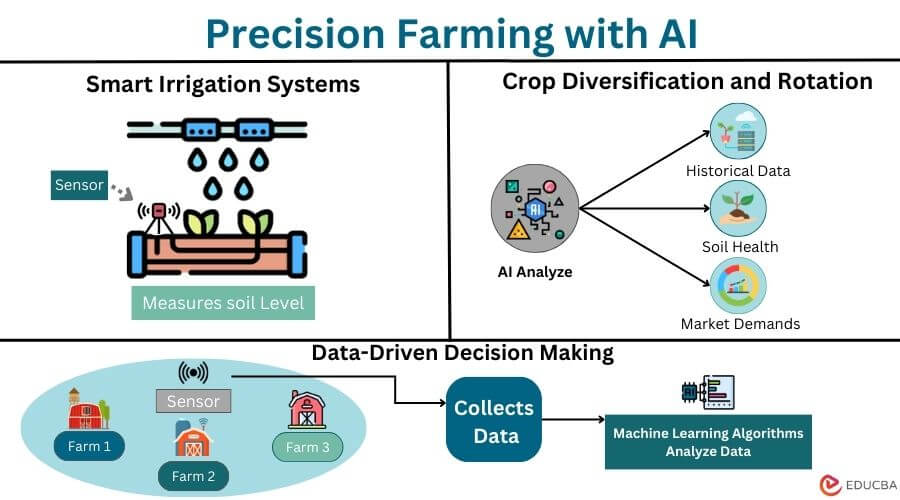Introduction to Artificial Intelligence in Agriculture
Artificial intelligence (AI) has begun a revolution in several industries, including agriculture. In recent years, AI technologies have been incorporated into agricultural practices, transforming traditional farming methods and enhancing efficiency, productivity, and sustainability.
AI in agriculture involves utilizing advanced algorithms, machine learning techniques, and big data analytics to scrutinize complex agricultural data and make well-informed decisions. Artificial intelligence applications in agriculture comprise crop monitoring, precision farming, predictive analytics, autonomous farming equipment, and livestock monitoring.
Table of Contents
- Introduction
- AI Technologies in Agriculture
- Crop Monitoring and Management
- Precision Farming with AI
- AI in Livestock Management
- Supply Chain and Logistics
- Challenges and Ethical Considerations
- Future Trends and Innovations
- Success Stories and Case Studies
AI Technologies in Agriculture
Here are some key Artificial Intelligence technologies in agriculture:
- Machine Learning in Crop Management: Machine learning models analyze huge amounts of data, such as historical weather patterns, soil quality, and crop attributes. These models provide insights into optimal planting times, crop varieties, and resource allocation, assisting farmers in making informed crop management decisions.
- Computer Vision for Plant Health Monitoring: Computer vision systems use cameras and image analysis to assess plant health and detect diseases, pests, and nutritional deficiencies. Early detection allows farmers to take corrective action, decreasing crop losses and the need for chemical treatments.
- IoT and Sensor Technology: IoT devices and sensors capture real-time data on soil moisture, temperature, humidity, and other variables. AI uses this data to generate actionable insights, allowing for more precise irrigation and resource management.
- Robotics and Drones in Farming: Planting, weeding, and harvesting are operations performed by autonomous farming equipment and drones with AI-driven systems. These technologies improve efficiency, reduce labor costs, and improve precision in various farming tasks.
Crop Monitoring and Management
Here are a few essential aspects of crop monitoring and management, as well as the technology that supports them:
1. Predictive Analysis for Crop Yield
Technology: Machine learning and data analytics
Description: Predictive analysis uses historical and real-time data on weather, soil conditions, crop health, and other variables to forecast crop yields.
Benefits: Farmers can make data-driven decisions, plan for optimal harvest times, and adjust strategies to maximize yields while reducing uncertainty.
2. Soil and Environmental Sensing
Technology: IoT sensors, drones, and satellite imaging
Description: Sensors in the soil and environmental monitoring devices collect data on soil moisture, temperature, nutrient levels, and weather conditions.
Benefits: Farmers use this data to determine the best planting times, irrigation schedules, and fertilizer applications for optimizing crop growth and resource utilization.
3. Disease and Pest Detection
Technology: Computer vision, AI, and remote sensing
Description: AI-powered cameras and sensors monitor crops for signs of disease, pests, or nutrient deficiencies. Remote sensing can also identify areas with potential issues.
Benefits: Early detection allows for targeted intervention, reducing the need for chemical treatments and preventing the spread of diseases or pests, ultimately preserving crop health and yield.
Precision Farming with AI
Precision farming, often known as precision agriculture, uses advanced technologies to optimize various aspects of farming practices. AI is important in precision farming because it provides intelligent solutions to improve productivity and sustainability. Here are three main components of AI-assisted precision farming:
1. Smart Irrigation Systems
Smart irrigation systems leverage sensors, IoT devices, and AI algorithms to keep track of soil moisture levels, weather conditions, and crop water requirements in real-time.
How it works: The sensors placed in the soil measure the moisture levels, and the collected data is sent to AI algorithms. The algorithms examine this information in conjunction with the weather forecast to determine the amount of water the crops require.
Benefits:
- Water Conservation: Smart irrigation ensures crops receive the appropriate amount of water, thus avoiding over-irrigation and water waste.
- Cost Efficiency: By optimizing water usage, farmers can reduce their water bills, saving costs.
- Increased Yields: Proper irrigation leads to healthier crops and higher yields, improving agricultural productivity.
2. Crop Diversification and Rotation
Crop diversification refers to the practice of producing multiple types of crops in the same region, whereas crop rotation refers to the practice of changing the type of crop cultivated in a single field over the course of a season.
How it works: To identify ideal crop diversification and rotation patterns, AI systems analyze historical data, soil health, and market demands.
Benefits:
- Soil Health: Different crops have different nutrient requirements, and diversity helps to preserve soil fertility by preventing the depletion of specific nutrients.
- Pest and Disease Management: Crop rotation disrupts the life cycles of pests and diseases, decreasing the need for chemical interventions.
- Sustainability: Diversified and rotational crops contribute to sustainable farming practices by protecting soil quality and biodiversity.
3. Data-Driven Decision Making
Data-driven decision-making in agriculture involves collecting, analyzing, and interpreting data from various sources, such as sensors, satellites, and historical records. AI algorithms process this data to provide valuable insights and recommendations.
How it Works: Data collected from different farm sensors and equipment is fed into AI systems. Machine learning algorithms analyze this data to offer insights into crop health, yield predictions, pest patterns, and optimal farming practices.
Benefits:
- Optimized Resource Use: Data-driven insights enable farmers to optimize the use of water, fertilizers, pesticides, and energy, reducing waste and environmental impact.
- Enhanced Productivity: AI-driven decisions improve crop yields and overall farm productivity.
- Risk Mitigation: Data analysis helps farmers anticipate and mitigate risks related to weather, pests, diseases, and market fluctuations, enabling proactive measures to protect crops and investments.
AI in Livestock Management
AI plays a significant role in improving livestock management in various ways, including:
1. Automated Livestock Monitoring
- Behavioral Analysis: AI-powered cameras and sensors can monitor the behavior of livestock. Changes in behavior, such as reduced activity or unusual movements, can be early indicators of health issues.
- Facial Recognition: AI actively recognizes and tracks individual animals through facial recognition, particularly for identifying and monitoring specific animals for health or production purposes.
- Environmental Monitoring: AI actively analyzes data from sensors monitoring environmental conditions in livestock facilities, such as temperature, air quality, and humidity, to ensure that animals are kept in optimal conditions.
2. Health and Nutrition Optimization
- Health Diagnosis: AI algorithms can process data from various sources, including blood tests, wearable devices, and images, to diagnose health issues in livestock. Early detection of diseases can lead to more effective treatment.
- Nutrition Management: AI can analyze the nutritional needs of individual animals and create customized feeding plans. This optimizes the use of resources and improves the overall health and growth of the livestock.
- Feed Quality Control: AI can assess the quality of feed ingredients and adjust rations accordingly, ensuring that animals receive the proper nutrients.
3. Predictive Livestock Breeding
- Genomic Selection: Genomic data can predict animal traits like milk production and disease resistance, improving herd quality through selective breeding.
- Reproductive Management: AI can help determine the best timing for insemination or natural breeding. By analyzing data on estrus cycles and other factors, it can increase the success rate of reproduction.
- Inbreeding Avoidance: AI can track the genetic relationships between animals in a herd to prevent inbreeding and maintain genetic diversity.
Supply Chain and Logistics
Here are some applications of AI in supply chains and logistics:
1. AI for Harvesting and Sorting
- Robotic Harvesting: AI-powered robots with computer vision can instantly identify and harvest ripe fruits and vegetables. This lowers the need for physical labor and speeds up harvesting processes.
- Sorting and Grading: AI algorithms can sort and grade agricultural products based on various criteria such as size, color, and quality. Automated sorting systems, driven by AI, ensure consistency and accuracy in the sorting process, leading to higher-quality products reaching the market.
2. Real-Time Monitoring and Tracking
- IoT Sensors and AI Analytics: Internet of Things (IoT) sensors placed on vehicles, containers, and packages collect real-time data on temperature, humidity, and location. AI algorithms analyze this data to ensure goods are stored and transported optimally.
- Predictive Maintenance: AI can predict equipment failures by analyzing data from sensors on machinery. This allows for proactive maintenance, reducing downtime, and ensuring that vehicles and machinery are in optimal working condition.
- Route Optimization: AI algorithms analyze traffic patterns, weather conditions, and historical data to optimize real-time delivery routes. This minimizes transportation costs, reduces fuel consumption, and improves delivery time accuracy.
3. Optimization of Distribution
- Demand Forecasting: AI analyzes historical sales data, market trends, and other variables to forecast demand accurately. This enables businesses to optimize inventory levels and avoid overstocking or understocking products.
- Warehouse Management: AI-powered systems optimize warehouse layouts, automate inventory management, and enhance order-picking processes. This leads to faster order fulfillment, reduced errors, and lower operational costs.
- Dynamic Pricing: AI algorithms in real-time actively analyze market demand and competitor pricing. This information is actively used to adjust prices dynamically, maximizing revenue during periods of high demand and ensuring competitiveness in the market.
Challenges and Ethical Considerations
Implementing artificial intelligence in various domains, including agriculture and logistics, comes with its own set of challenges and ethical considerations:
1. Data Privacy and Security
- Data Ownership: One key issue is identifying who owns the data generated by artificial intelligence systems in agriculture, such as farm and crop data. Farmers, technology providers, and data platforms may all have competing interests in data ownership.
- Data Security: As more data is collected and exchanged, the risk of data breaches and cyberattacks grows. It is critical to safeguard sensitive agricultural data against unauthorized access and data theft.
- Informed consent: Farmers and stakeholders should have explicit, informed permission to use and share their data. Transparent data-use policies and consent methods are required.
2. Ethical Use of AI in Agriculture
- Environmental Impact: We should deploy AI technology to support sustainable agricultural practices while minimizing environmental harm and resource depletion.
- Fairness and Bias: AI algorithms should be built and evaluated to eliminate bias and discrimination, especially in applications like loan approval, land appraisal, and resource access.
- Job Displacement: Implementing AI may raise concerns regarding job displacement in rural areas. We should consider strategies for retraining and upskilling the workforce.
- Responsible Innovation: Developers and authorities must evaluate the ethical implications of artificial intelligence use in agriculture and mitigate any unforeseen consequences.
3. Access to Technology in Rural Areas
- Digital Divide: Rural areas may lack access to high-speed internet and other necessary infrastructure for AI adoption. Addressing the digital divide is crucial to ensure that all farmers benefit from these technologies.
- Affordability: AI technology can be expensive, making it inaccessible to small-scale and resource-limited farmers. Initiatives to make technology more affordable and accessible are essential.
- Education and Training: Rural farmers and agricultural workers may require training to use AI tools effectively. Providing training and support is essential for successful adoption.
Future Trends and Innovations
Rapid technological advances are actively shaping the future of agriculture. Some interesting agricultural developments and innovations are expected to play a key role:
1. Blockchain and AI in Food Traceability
- Transparent Supply Chains: Blockchain technology combined with AI offers end-to-end traceability of food products. Consumers can track their food from farm to table, ensuring food safety and quality.
- Smart Contracts: Smart contracts on blockchain systems can automate transactions and agreements between farmers, wholesalers, and retailers, reducing bureaucracy and assuring fair pay for all stakeholders.
- Data Integrity: Blockchain ensures the integrity of agricultural data, preventing tampering and fraud. AI systems can analyze this data for insights, improving overall supply chain efficiency.
2. AI-Enabled Urban Farming
- Vertical Farming: In vertical farming, AI-controlled vertical farms actively optimize the use of space, water, and nutrients. By tailoring environmental conditions precisely to plant needs, these farms can actively produce high yields in urban areas with limited space.
- Precision Agriculture in Cities: artificial intelligence sensors and data analytics enable precision agriculture practices in urban settings. Real-time monitoring of crops, automated irrigation, and data-driven decision-making improve crop health and productivity.
- Localized Food Production: AI also helps design and manage small-scale urban farms, reducing the need for long-distance transportation and promoting local, sustainable food production.
3. AI for Climate-Resilient Agriculture
- Climate Prediction Models: With the help of AI algorithms, climate prediction models have become more accurate. These algorithms actively process vast amounts of climate data and actively predict weather patterns to assist farmers in making informed decisions about planting, irrigation, and harvesting schedules. This actively helps mitigate the impact of climate change.
- Crop Selection and Breeding: AI analyzes crop genetics and environmental data to develop climate-resilient crop varieties. These crops are better adapted to withstand extreme weather conditions, ensuring stable yields.
- Smart Irrigation and Water Management: AI-powered irrigation systems analyze soil moisture levels, weather forecasts, and crop needs in real-time. This precision reduces water wastage and supports sustainable water management practices.
Success Stories and Case Studies
Here are a few success stories and case studies:
1. Blue River Technology – See & Spray Technology
- Blue River Technology, a John Deere company, created a precision farming solution that distinguishes crops and weeds using computer vision and machine learning.
- The technology can recognize and accurately target weeds using cameras and AI, delivering pesticides only where needed. This eliminates the use of chemicals, lowers expenses, and encourages better crops.
- Herbicide use was reduced significantly while crop yields were maintained or even increased.
2. The Climate Corporation – Climate FieldView
- The Climate Corporation, a subsidiary of Bayer, provides a platform that merges AI and data analytics to give farmers actionable insights.
- Climate FieldView collects data from various sources, including sensors, drones, and satellites. It analyzes the data and gives farmers recommendations for planting, fertilizing, and harvesting.
- Farmers using Climate FieldView have reported higher yields and more efficient resource usage.
3. IBM Watson Decision Platform for Agriculture
- IBM Watson Decision Platform for Agriculture includes weather data, IoT sensors, AI, and machine learning to provide farmers with predictive insights and suggestions.
- The platform provides personalized planting, irrigation, and harvesting assistance by analyzing weather forecasts, soil conditions, and crop data.
- Farmers who use the platform report higher yields, lower water usage, and better crop quality overall.
Conclusion
Artificial intelligence in agriculture is becoming increasingly important as it leads to more efficient and sustainable farming practices. AI can be applied to precision farming, crop management, livestock monitoring, and supply chain optimization. Through data-driven decision-making, this technology has the potential to revolutionize agriculture by raising crop yields, reducing resource waste, and promoting environmental conservation. With ongoing advancements, AI is expected to improve food production further, enhance resilience in the face of climate change, and ensure a more sustainable and prosperous future for the agricultural industry.
FAQs
Q1. What are some AI applications in livestock management?
Answer: There are several AI applications in livestock management, including automated monitoring of animal behavior, health diagnosis, predictive breeding, and environmental monitoring. These technologies are beneficial for enhancing animal welfare and production efficiency.
Q2. What role does AI play in sustainable agriculture?
Answer: AI plays a crucial role in sustainable agriculture by optimizing the usage of resources, reducing chemical inputs, minimizing water wastage, and enhancing precision farming. It helps farmers make informed decisions that promote environmental conservation and long-term sustainability.
Q3: Can AI be used for pest control in agriculture?
Answer: Yes, AI can also be used for pest control in agriculture, where machine learning algorithms evaluate data from sensors and drones to identify early signs of pest infestation. This early detection enables farmers to take timely measures, reducing the damage caused by pests.
Recommended Articles
We hope that this EDUCBA information on “Artificial Intelligence in Agriculture” was beneficial to you. You can view EDUCBA’s recommended articles for more information.






